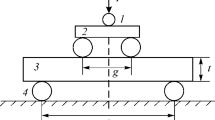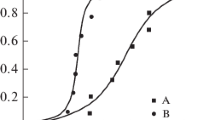Abstract
It is pointed out that the Weibull multiaxial treatment of brittle strength contains limitations which are not present in the more familiar uniaxial formulation. Provided these limitations are satisfied, it is possible to use tension or bending data to predict multiaxial behavior when at least one principal stress is tensile. This is illustrated for the Brazilian disk test (diametral compression of a disk). Predictions based on bending tests agree well with observed strength values in disk tests on two types of rocks.
Résumé
Il est démontré que le traitement de la fragilité par la méthode multiaxiale de Weibull est sujet à des restrictions que l'on ne rencontre pas dans la formulation uniaxiale classique. Dans la mesure où ces conditions sont satisfaites, il est possible d'utiliser les données empiriques de traction et de flexion pour prédire un comportement multiaxial quand au moins une des forces principales est une force de traction. A titre d'illustration le test dit “Brazilian Disk Test” est exposé (compression diamétrale d'un disque). Les calculs faits à partir des tests de flexion concordent bien avec les valeurs des résistances observées dans le test du disque, effectué sur deux types de matériaux.
Zusammenfassung
Es wird gezeigt, daß die dreidimensionale Weibull'sche Theorie für spröde Materiale Bedingungen enthält, die die gewöhnlichere eindimensionale Theorie nicht besitzt. Wenn diese Bedingungen erfüllt sind und wenigstens eine der Hauptspannungen eine Zugspannung ist, können die Daten von einfachen Spannungs und Biegungsversuchen verwendet werden um mehrdimensionale Probleme zu berechnen. Dies wird für das “Brazilian Disk Test” (diametralzusammengedrückte Scheibe) demonstriert, Ergebnisse die mit Hilfe von Daten aus Biegeversuchen gewonnen wurden stimmen gut überein mit Festigkeitswerten die an Scheibenversuchen mit zwei verschiedenen Gesteinsarten beobachtet wurden.
Similar content being viewed by others
References
C. W. Marchall and A. Rudnick, Conventional Strength Testing of Ceramics in Fracture Mechanics of Ceramics, to be published by Plenum Press.
F. L. L. B. Carniero and A. Barcellos, Union of Testing and Research Laboratories for Materials and Structures, No. 13 (1953).
M. C. Shaw, P. M. Braiden and G. J. DeSalvo, ASME Paper No. 73-WA/Prod-17.
M., Mellor and I., Hawkes, Eng. Geol., 5 (1971) 173.
A., Rudnick, A. R., Hunter and F. C., Holden, Mater. Res. Std., 3 (1963) 283.
R., Berenbaum and I., Brodie, Brit. J. Appl. Phys., 10 (1959) 281.
C., Fairhurst, Int. J. Rock Mech. Mining Sci., 1 (1964) 535.
J. A., Hudson, Int. J. Rock Mech. Mining Sci., 6 (1969) 91.
W. Weibull, Ingvetenskakad. Handl., No. 151, Stockholm (1939).
H. L., Oh and I., Finnie, Int. J. Fracture Mech., 6 (1960) 287.
K. P. L., Oh and I., Finnie, Int. J. Fracture Mech., 6 (1970) 333.
O. K. Salmassy, E. G. Bodine, W. H. Duckworth and G. K. Manning, WADC Technical Report 53-50, Part II (1955) 46.
N., Davidenkov, E., Shevandin and F., Witmann, J. Appl. Mech., 14 (1947) 63.
S. S. Manson, Thermal Stress and Low-Cycle Fatigue, McGraw-Hill Book Co. (1966) 295.
L. J., Broutman and R. H., Cornish, J. Am. Ceramic Soc., 48 (1965) 519.
R. E. Ely, U. S. Army Missile Comm. Report, No. RR-TR-70-23 (1970).
E. K., Priddle, J. Strain Analysis, 4 (1968) 81.
W. M. Mair, Gr. Britain, Nat. Eng. Lab. Report No. 261 (1966).
K. P. L., Oh, Ö., Vardar and I., Finnie, Int. J. of Fracture, 9 (1973) 372.
H. W., Babel and G., Sines, J. Basic Engineering, 90 (1968) 285.
O. K. Salmassy, E. G. Bodine, W. H. Duckworth and G. K. Manning, WADC Technical Report 53-50, Part II (1955) 53.
W. H. Dukes, Handbook of Brittle Material Design Technology, AGARDograph 152, North Atlantic Treaty Organization (1971).
S. B. Batdorf and J. G. Crose, to be published in Trans. ASME, J. App. Mechanics.
G., Hondros, Australian Journal of Applied Science, 10 (1959) 267.
N. A. Weil and I. M. Daniel, The Influence of Stress Gradient on the Strength of Brittle Materials, ASME Paper 63-WA-228.
Author information
Authors and Affiliations
Rights and permissions
About this article
Cite this article
Vardar, Ö., Finnie, I. An analysis of the Brazilian disk fracture test using the Weibull probabilistic treatment of brittle strength. Int J Fract 11, 495–508 (1975). https://doi.org/10.1007/BF00033536
Received:
Issue Date:
DOI: https://doi.org/10.1007/BF00033536




